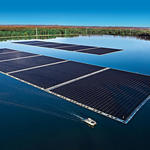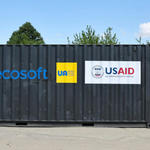| |
| |
|
The 411 for Water Treatment Professionals
|
|
|
|
|
| |
| |
| |
|
North America's Largest Floating Solar Project Powers Water Treatment Facility
|

Organizations wanting to go green typically install rooftop or ground-mounted solar projects or buy renewable energy credits. But a water utility in New Jersey has embraced a novel approach, installing North America’s largest floating solar project. Consisting of 16,510 solar panels, the 8.9-megawatt (MW) solar array covers 17 acres of the Canoe Brook reservoir in Short Hills, N.J. The clean power generated is enough to power 1,400 homes annually and will provide approximately 95% of the power needs for New Jersey American Water’s Canoe Brook Water Treatment Plant.
|
|
| |
|
USAID Provides Kherson Water Utility with Mobile Water Treatment System
|

The U.S. Agency for International Development USAID, together with partners, has provided the Kherson water utility with a mobile water purification system that can provide clean water to 25,000 people a day. "More U.S. support for Ukrainians affected by the floods caused by the destruction of the Kakhovka Dam. USAID, in cooperation with the private sector and civil society, has provided the Kherson water utility with a mobile water treatment system that can provide clean water to 25,000 people per day," the diplomatic mission said.
|
|
| |
|
|
| |
| |
| |
|
The World’s Largest Wastewater Treatment Plant
|
It seems fitting that the country with the world’s longest river hosts the world’s largest wastewater treatment plant. Guinness World Records has recognized the Bahr El-Baqar treatment plant on Egypt’s Sinai Peninsula as deserving of this title. The facility achieved a capacity of 64.8 m3 (2,288 ft3) per second in June 2021 and currently treats 5 million m3 of wastewater per day. Compact Hydrotech disc filters from Veolia Water Technologies provide two to three times more filtering area compared to drum filters of the same external dimensions.
|
|
| |
|
Using Vacuum-Uv, Ozone, and Activated Carbon for Micropollutant Removal in Wastewater Treatment
|
A MUDP project (The Environmental Technology Development and Demonstration Program) at the Slagelse Wastewater Treatment Plant, shows that low-dose ozonation and vacuum-UV can extend the lifespan of used activated carbon filters, so they can purify micropollutants, such as industrial chemicals and medicine residues while reducing carbon footprint. The purpose of the project has been to test new, cost-effective solutions for removing medicines and other micropollutant substances as well as antibiotic-resistant bacteria.
|
|
| |
|
|
| |
| |
| |
|
How connected worker technology boosts the safety of water treatment plants
|
Providing clean water to communities and commercial facilities requires multiple technologies and operational practices anchored in safety. Water treatment plants are striving to modernise operations and adopt digital solutions to overcome water treatment challenges, meet customer demands and guarantee the safety of physical, chemical and biological processes and water.
|
|
| |
|
|
| |
| |
| |
|
Prevalence of Antimicrobial Resistance in a Full-Scale Drinking Water Treatment Plant
|
Antibiotic resistance in drinking water has received increasing attention in recent years. In this study, the occurrence and abundance of antibiotic resistance genes (ARGs) in a drinking water treatment plant (DWTP) was comprehensively investigated using metagenomics. Bioinformatics analysis showed that 381 ARG subtypes belonging to 15 ARG types were detected, and bacitracin had the highest abundance (from 0.26 × 10-2 to 0.86 copies/cell), followed by multidrug (from 0.57 × 10-1 to 0.47 copies/cell) and sulfonamide (from 0.83 × 10-2 to 0.35 copies/cell).
|
|
| |
|
Application of Manganese Oxides in Wastewater Treatment: Biogeochemical MN Cycling Driven by Bacteria
|
Manganese oxides (MnOx) are recognized as a strongest oxidant and adsorbent, of which composites have been proved to be effective in the removal of contaminants from wastewater. This review provides a comprehensive analysis of Mn biochemistry in water environment including Mn oxidation and Mn reduction. The recent research on the application of MnOx in the wastewater treatment was summarized, including the involvement of organic micropollutant degradation, the transformation of nitrogen and phosphorus, the fate of sulfur and the methane mitigation.
|
|
| |
|
Consumers and Businesses Look to WaterSense and Save 7.5 Trillion Gallons of Water
|
The U.S. Environmental Protection Agency released its 2022 WaterSense Accomplishments Report today, noting that consumers using WaterSense labeled products saved more than 1.1 trillion gallons of water in 2022. Since, EPA’s WaterSense program was launched in 2006, consumers and businesses have saved more than 7.5 trillion gallons of water by purchasing water-saving plumbing fixtures and irrigation products.
|
|
| |
|
|
| |
|
|